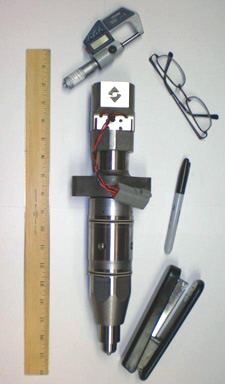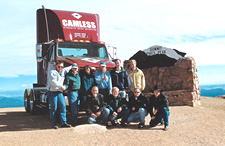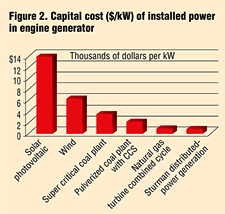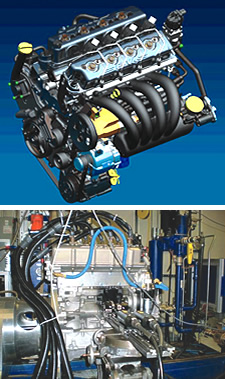 BioCycle September 2011, Vol. 52, No. 9, p. 23
BioCycle September 2011, Vol. 52, No. 9, p. 23
Through digital valves, hydraulics and microprocessor controls, Sturman Industries has developed technologies that improve fuel efficiency, reduce emissions and enable use of alternative fuels in traditional engines.
Nora Goldstein
IN the 1960s, after earning a Master’s degree in mechanical engineering at the University of Southern California, Eddie Sturman began working for Bell Aerospace, a contractor to NASA, the National Aeronautics Space Administration. NASA required efficient and lightweight valves to control the thrusters in its Apollo spacecraft engines. Actuators being used at the time required constant energy to power the Apollo spacecraft in space.
“It was very frustrating because I was working on the project and couldn’t meet the requirements for a long time,” Sturman recalls. “Then, at a conference I was attending in Florida, I unintentionally walked into a session on electronics. This was just at the point where that industry was making a change from analog to digital. Analog devices needed power all the time when on. Using power generates heat that has to be dissipated so the devices ended up being big and slow. The idea behind digital was that if we can eliminate the demand for constant energy then devices can be smaller and faster. I was intrigued by the concept, and wanted to see if digital applied to the field of magnetics that I was working in. I developed a very efficient valve control actuator that consumed very little energy. By replacing valves that used constant energy to hold them open with efficient, digital, electronically controlled valves, energy use in the system was reduced by only being needed to open or close the valves.”
Sturman’s work resulted in five patents and systems extensively used in the space program, and “probably was one of the energy-saving factors that enabled Apollo 13 to find the additional power it needed to return to earth,” noted NASA’s Spinoff publication in 2003, the year Sturman was inducted into the Space Technology Hall of Fame for his invention. “Basically, I introduced digital technology to the mechanical world and was immediately very successful with that,” he explains. “After applying the concepts to the space program, I realized it applied to almost anything. Traditionally, the mechanical world was based on ‘if you need something that needs to do more you make it bigger.’ In the digital world, it was just the opposite. These technologies enable systems to be smaller, for there is less heat (energy) that needs to be dissipated through the system; faster, because increasingly smaller masses respond quickly to the split second impulses generated by the electronics; and efficient, for less energy is used and less is wasted to turn the valve on and off. The end result is flexibility and intelligence.”
 One of the first applications of his technology was in battery and solar-powered automated irrigation systems. “I was born in Israel and went to an agricultural high school,” says Sturman. “I lived on a farm and in Israel, water efficiency is very important. After that, I began applying the digital valve technology to diesel engines to make them operate more efficiently. I became involved in the engine world in 1985, which was just beginning to incorporate electronics into engines in an industry that was resisting change. I was brought in as a consultant and realized that while change is necessary, it would be very challenging to do through a big company that did not want to change.”
One of the first applications of his technology was in battery and solar-powered automated irrigation systems. “I was born in Israel and went to an agricultural high school,” says Sturman. “I lived on a farm and in Israel, water efficiency is very important. After that, I began applying the digital valve technology to diesel engines to make them operate more efficiently. I became involved in the engine world in 1985, which was just beginning to incorporate electronics into engines in an industry that was resisting change. I was brought in as a consultant and realized that while change is necessary, it would be very challenging to do through a big company that did not want to change.”
At the same time, however, the trucking industry was faced with government mandates to reduce emissions from diesel engines. The challenge was to develop components with the capability to reduce emissions but maintain the engine’s capability to perform, i.e., not lose the horsepower and torque needed to pull the payloads. “Essentially, we needed to control the combustion process in order to control the emissions,” explains Sturman. “That required removing the mechanical restrictions and modernizing the engine by putting in new controls provided by digital valve technologies.”
Adds Carol Sturman, cofounder and president of Sturman Industries: “Internal combustion engines have been fundamentally the same for 100 years. It is a good invention because it directly converts chemical energy in fuel to mechanical motion. What was needed were technologies and controls to optimize its performance. Our advanced technologies developed through Eddie’s work in the space program – creating the interface between electronics and mechanical motion – was the foundation of the technologies Sturman Industries has developed to provide the necessary controls to optimize performance of the internal combustion engine. What we have done is make it precise and smart and adaptable.”

Engines have been developed for specific fuel types, e.g., gasoline, diesel, natural gas, however the fuel and engine type have to be matched perfectly. “Essentially, the mechanical controls forced industry to have fuels exactly matched to the engine,” continues Eddie Sturman. “That has really hurt the commercial viability of alternative fuels in existing engines.”
And this is where Sturman Industries and BioCycle’s worlds intersect. Sturman’s smart engine technologies enable use of alternative fuels (including renewable natural gas derived from anaerobic digestion) in standard automotive, truck and stationary engines. “The quality of the fuel isn’t as relevant as the capabilities of the engine to utilize the fuel,” explains Carol Sturman. “We need smart engines, not smart fuels. Today’s energy industry is focusing on engineering alternative fuels to ‘drop into’ existing engine technology. We believe it should be the exact opposite – the engine needs to find the sweet spot for whatever the fuel is.”
The Sturmans view their technologies as the bridge to connect the internal combustion engine of the 20th century to carbon neutral and noncarbon fuels of the 21st century, including biodiesel, renewable natural gas, ethanol and, in the more distant future, carbon-free anhydrous ammonia that can be created from wind or solar and stored to provide energy using a Sturman engine whenever and wherever needed. Rapid deployment of technologies to be able to cross the bridge is urgent. Traditional energy reserves are being depleted and accessing new fossil fuel sources comes with high environmental and economic costs. Add to that the excess carbon in the atmosphere, and the need for change is more than apparent.

BUILDING IT BETTER
In 1989, Carol and Eddie Sturman formed Sturman Industries to “provide better products to help protect the environment and save natural resources,” according to the company’s website. Sturman Industries started in California, but soon moved to a mountain top campus in Woodland Park, Colorado. “The purpose of our company is to improve the world through our technologies and culture,” says Carol Sturman. “And part of our culture is to be very close to nature. We believe it brings the best out in people.”
Figure 1 captures how Sturman Industries’ engine technologies have evolved since the company began. The digital valve is at the heart of every Sturman innovation.
“Sturman’s digital valve is … a physical valve whose actuation (the physical opening and closing) is handled through a combination of magnetic energy and hydraulics,” explained Todd Neff in a 2001 article in Front Range TechBiz. “But not just any magnetic energy. In the case of a traditional solenoid valve, a spring presses the valve closed until a rush of electromagnetism pries and holds it open through a sustained flow of energy through an electromagnetic coil. The Sturman digital valve employs no springs. Residual magnetism from an electric pulse indefinitely holds the valve’s driving mechanism in an open or closed position until a second pulse at a different point in the valve commands the opposite action. Pressurized hydraulic fluid piggybacks on this process, flowing through the digital opening and supplying the pressure needed to physically open and close valves or supply fuel injection in an engine block. By using residual magnetic energy as the triggering force and hydraulics as the driving force of the operative valve, Sturman’s digital valve operates more quickly, uses far less energy and generates a good deal less heat than its predecessors.”
The company focused initially on introducing a fuel injector technology. “That was the application – integrating our digital valve technology into fuel injector systems – I had been working on before starting Sturman Industries,” says Eddie Sturman. “Industry experts viewed combustion – converting fuel to motion by combining fuel and air in the right proportion – as uncontrollable because of the speed at which that occurs. We challenged that idea. Based on our experience with digital valves, we knew that if we could control the speed of combustion, we could control the emissions. Digital valves can control the mix of fuel and air during combustion, so you get more energy and you need less fuel.”
In 1993, Sturman Industries began work with a major engine manufacturer to introduce the first fuel injector with digital valve control that is hydraulically driven to handle any liquid fuel. The technology was designed to achieve ultra low NOx (nitrous oxide) emissions without compromising fuel consumption and engine performance. The first applications were in diesel engines.

THE “CAMLESS” ENGINE
The next link in the chain, explains Sturman, was to control the intake of air into the combustion chamber. This involves when and how much air gets into the combustion chamber and once burned, to have control of the exhaust to get it out. “We needed to get rid of the mechanical limitation so we could not only make combustion of existing fuels cleaner, but also open up possibilities to use alternative fuels,” he says.
Research and development led to the hydraulic valve actuation (HVA) system or “camless engine,” first introduced in 1995. As explained in an article in NASA Spinoff 2004 (www.sti.nasa.gov/tto/Spinoff2004), “instead of using a traditional valve train consisting of a camshaft, push rod or cam chain, lifters, rocker arms, and valve springs, the camless engine utilizes HVA to open and close engine valves. HVA eliminates the mechanical linkage between the engine valves and the camshaft and allows for fully flexible engine valve operation. In modern-day engines, the camshaft contains ‘lobes’ (also called cams) that push against the engine valves to open and close them as the camshaft rotates. The size of these lobes determines the timing of the opening and closing of the valves, which allow the flow of fuel and oxygen into the engine’s cylinders. This timing is critical and can have a great impact on an engine’s performance at different speeds. In the Sturman camless system, however, timing is flexible and can be optimized for idle, acceleration, or full power, thus allowing the engine to ‘breathe easy’ and perform well at all speeds. With a healthier respiration process, the camless engine offers cleaner emissions.”
In 2000, history was made as a big-rig truck equipped with a Sturman HVA system became the first camless vehicle to make it to the top and back of Pikes Peak in Colorado without shutting down the engine. Notes NASA’s Spinoff, “the accolade took place at the annual Pikes Peak International Hill Climb, the second-oldest motor race in U.S. history. One by one, vehicles race against the clock as they climb more than 12 miles to the top of the 14,110-foot summit, all while steering through 156 hairpin turns. In the same year, Sturman Industries successfully took a camless truck on a 10,000-mile tour across America.” In New York City, at the tail end of its 10,000-mile journey across the U.S., Sturman Industries technology incorporated into a Navistar truck was awarded with a “Best of What’s New” award from Popular Science magazine.
According to a 2010 presentation by Sturman Industries at an Ethanol Summit, the digital HVA eliminates throttling losses, controls exhaust temperatures for optimal catalyst performance, has a 7 to 20 percent reduction in fuel consumption with conventional fuels, a 20 to 40 percent efficiency improvement with alternative fuels, and is multifuel compatible, i.e., when designed for multifuel use an engine equipped with an advanced Sturman HVA Adaptive system can use ethanol, gasoline, diesel, biodiesel, natural gas or biomethane. The HVA has been demonstrated on engines ranging from a 250 cc gasoline up to a 15L diesel/natural gas engine. It also has been tested for distributed power generation.

Figure 2 compares the capital cost – $/kW of installed power – of the Sturman HVA Adaptive system and controls installed in an engine generator. “The Sturman Adapt has the potential of being one-third less capital cost than a combined heat and power natural gas turbine,” says Carol Sturman.
DEPLOYING ALTERNATIVE FUELS
Sturman explains that the reason its engine technology is “fuel agnostic” is because all the engine controls are done with hydraulic fluid and not with the fuel itself. “We don’t really care what the fuel is, we care about what it does,” he says. “The fuel needs to ignite and different fuels ignite at different temperatures. The sensors know when the fuel is ignited, and then make adjustments to optimize combustion to provide the necessary fuel efficiency, horsepower and torque. Because the system atomizes fuel thermally rather than mechanically, it is compatible with almost any fuel type.”
Among the challenges the company has had to address in deploying its technologies has been the properties of engine fuels themselves. “For good combustion, the best thing to have is a gas because the air and fuel molecules have to be combined,” notes Sturman. “For example, diesel has to be atomized, i.e., taken from a liquid state into a vapor. For full combustion, it is optimum to have a gas already. Gasoline is right on the border between a liquid and a gas – it is much closer to a vapor. Natural gas is even better because it is a gas and burns very cleanly.”
But, Sturman continues, what is good for combustion is not good for energy storage and getting fuel to the engine. For example, diesel stores a lot of energy but isn’t optimum for combustion without being atomized into a vapor, whereas natural gas doesn’t have as much energy content but is very good for combustion. “What our engine technologies do is make the necessary adjustments – essentially find the sweet spot for fuel to combust in order to get maximum performance from the engine, fuel efficiency and clean emissions.”
The Sturmans use the analogy of a fireplace to illustrate this point. “Basically, you need paper to get the fire started, and then can use all different kinds and qualities of wood to keep it burning,” they explain. “You control the temperature the fire burns at by controlling the air. That is what we are doing. Instead of trying to control the fuel, we control the air. You can throw anything into the fireplace. As long as it can burn, you are better off adjusting the air for what is being burned. In a fireplace, we are the intelligence to make that adjustment. Because a vehicle isn’t intelligent, we need to put in smart systems.”
The other analogy used during our interview was the human body’s ability to consume any type of food. “We can eat anything – fruits, vegetables, meats, grains, fish, etc.,’ they add.’ All are different fuels, and the body is smart enough to know how to process each one. The same is true with engines: We need engines that are flexible and smart to get the best out of the fuel. They recognize the properties in the fuel and make all changes that are necessary. The engine should be able to change for any driving condition and any fuel. If that does not happen, no new fuels can compete with existing fuels.”
Ethanol is a case in point. “It has great properties that are better than either diesel or gasoline,” explains Eddie Sturman. “You can go further on one gallon of ethanol than one gallon of gas. But you need to be able to control the combustion to take advantage of it. However, ethanol was forced to be used in gasoline engines. It didn’t get a chance.” That said, he adds, in order to use ethanol in a smart engine, the engine parts need to be chemically compatible with the properties of ethanol. “The first thing is make sure the tank and valves have the proper materials.”
READY FOR PRIME TIME
Various components developed by Sturman Industries have been used in commercial engine production over the past decade. For example, Navistar (formerly International Truck) used Sturman’s fuel injectors in production of engines for Ford’s power stroke diesel pickup truck. “Navistar was making about 3 million of these fuel injectors a year, primarily for Ford,” says Sturman. “Over a 5-year period, starting around 2002, it manufactured about 15 million of them, using six injectors in every engine. Then Ford decided to make its own engine and not use Navistar any longer.”

In addition to Navistar, some of Sturman Industries’ customers include the Department of Defense, General Motors, Tenneco, an international ship engine builder, a distributed power supplier, and multiple national laboratories, universities and research institutes. For example, this past spring, the company was selected by the U.S. Army Research, Development and Engineering Command (RDECOM) to “examine, develop, and demonstrate the use of an advanced high pressure injection system in a heavy-fuel, rotary diesel engine for unmanned and manned ground vehicle applications,” according to a news item in Green Car Congress, an on-line newsletter. “For a military rotary engine application, Sturman will utilize features such as flight weight design, unique injection spray, custom packaging and integrated electronics.” Fuel injectors using Sturman technology are already provided to the Army’s MRAP (Mine Resistant Ambush Protected) vehicles in the battlefield.
Mike Millikin, founder and editor of Green Car Congress, has been writing about Sturman Industries for the past five or six years. “For anybody who pays attention to camless engine possibilities, Sturman is kind of the go-to group,” he says. “They are a significant player, although other companies have been working on this as well. Basically, Sturman has two things at work: greater control of valves and more flexibility of the combustion stream. The ability to control valves and work with the fuel/air mixture in the cylinder in a more precise way – and drive efficiency up and emissions and fuel consumption down – that is the Holy Grail for the engine guys.”
For example, the company has converted a Volkswagen Jetta engine in its Woodland Park facility to be “more flexible and more intelligent,” says Sturman. “We removed the mechanical camshaft and the fuel injector and programmed the microprocessor to send instructions to the digital valves so we can open and close other valves that control the fuel, the air and the exhaust based on the program that the microprocessor is executing. Essentially, we’ve removed the mechanical controls that limit the performance, but kept the engine itself the same. This research, along with work we have done on other automotive, truck and stationary engines, proves that retrofits of existing engines are possible.”
Sturman Industries is ready to mass market the products it has developed. “We have invested a lot of our own money as well as money from the Department of Defense and the U.S. Department of Energy and our industry business partners to develop our technologies and systems,” says Carol Sturman. “Now we are at the point of implementation. Part of our approach to date has been to work with industry to utilize our technologies and systems because it has been to their benefit to jump into the future instead of being left behind. We can continue down that path, albeit on a larger and broader scale, by leveraging existing manufacturing capability. Or we can start from scratch, building our own manufacturing capacity. It depends on how fast the technologies need to be implemented – and how much capital can be raised to make that happen. There is no question that we need to get sustainable and practical solutions into the marketplace as quickly as possible.”
But investment in production is hefty, she adds, easily in the range of $100 million as opposed to teaming up with a manufacturer that has the capability. “Either way, it is a substantial investment,” she adds, “but we are ready to find funding and bring our systems to market on a larger scale. Technically, we know where we are and where we need to go. Sturman Industries has been leading the mechanical world into the digital age. Even though we are 20 years ahead of most of the industry, what is required to take these next steps doesn’t take anything exotic. It is still using the internal combustion engine and the manufacturing process, but taking advantage of more sophisticated tools.”
Eddie Sturman contrasts the marketplace today versus when he developed the digital valve for the space program. “There was leadership at the top and no competition at that time,” he says. “We were able to start something new without having to fight with existing infrastructure. While the infrastructure challenges are greater today, with smart engines and alternative fuels, the transition is happening. There is definitely strong interest.”
He adds that the camless engine and Sturman Industries’ other technologies have two fundamental elements. “One part is the brain – the software to program a microprocessor to do what needs to be done. That is a very big part. It takes time and very highly talented people in the computer world. The other part is the mechanical side. New valves have to be made and installed in engines. We get rid of the camshaft and replace it with small, fast valves that have a lot of flexibility and very precise controls.”
Quips Carol Sturman, “It is rocket science we are talking about, but it doesn’t take rocket science to take the next steps toward commercialization.”
Dan Sullivan assisted with reporting for this article.
 p. 23
p. 23
Conference Keynoters
Carol and Eddie Sturman, founders of Sturman Industries, are the Keynote Speakers at BioCycle’s 11th Annual Conference on Organics Recycling From Renewable Energy, October 31-November 1-2, 2011 in Madison, Wisconsin. The Sturmans will share their story and highlight the importance of smart engine technologies in advancing the renewable energy from organics recycling industry. See pages 31-34 of this issue for conference details.
p. 27
Meeting California’s Ultra Low Emissions Standard
STURMAN Industries was awarded a grant in 2010 from the California Energy Commission’s (CEC) Public Interest Energy Research (PIER) program for $997,696 to essentially transform a diesel engine into an advanced natural gas engine. The research project, “Improving Efficiency of Spark Ignited, Stoichiometrically Operated Natural Gas Engines,” was completed this past spring. The final report on the research is undergoing internal review by PIER program officials and should be released to the public soon. According to a press release from Sturman Industries, its camless engine technology was “the key enabler for achieving breakthrough thermal efficiencies while meeting the ultra-low emission requirements set by the California Air Resources Board.” The work was performed on a heavy-duty 15L diesel engine platform that serves both the transportation and power generation markets.
“Stoichiometric engines have very low emissions by way of a 3-way catalyst, but suffer from lower efficiencies, in particular at part load,” explains Miguel Raimao of Sturman Industries. “Lean-burn engines deliver good fuel economy by running unthrottled, but require very expensive after treatment to meet emission requirements. It was clear we had to combine the best attributes of each approach, so we chose to apply our Hydraulic Valve Actuation (HVA) system [camless engine] to eliminate the throttling losses, with a simple 3-way catalyst to clean up remaining emissions. The result was peak engine efficiencies over 40 percent and up to 18 percent reduction in fuel consumption at part load. This technology is a solution for California’s interest to utilize biomethane, also known as renewable natural gas. This engine can respond to the varying qualities of RNG.”
The stock production diesel engine was fitted with a commercial natural gas fuel system and Sturman’s HVA system, along with its Sturman Total Engine Controller. The CEC test focused specifically on the application to stationary power generation. “The application of variable valve actuation combined with Sturman’s closed-loop combustion control allowed this 15L engine to meet its performance requirements even with low quality natural gas,” says Dan Giordano, Program Lead for the CEC program.
In response to a question by BioCycle about whether the findings of this research are a potential “game changer” in terms of renewable fuels and emissions, Pablo Gutierrez of the CEC, manager for this research project, replied: “At this time, it is too soon to tell if this innovative research is a ‘game changer.’ However, Sturman Industries has conducted excellent research in the areas of renewable fuels, and improving the performance and reduction of air emissions from internal combustion engines. If an organization (i.e., Cummins, Caterpillar) considers incorporating this novel design into their product line, it could produce dramatic results. Sturman Industries’ design provides for an independent control of valve timing and duration combined with cylinder deactivation capability.”
The PIER program supports public interest research and development that helps improve the quality of life in California by bringing environmentally safe, reliable, and affordable energy services and products to the marketplace. For more information, visit www.energy.ca.gov/research/.
September 19, 2011 | General










